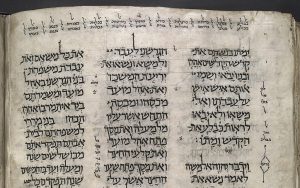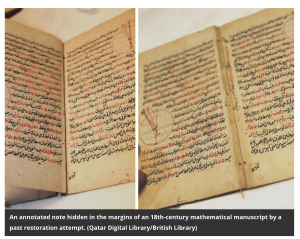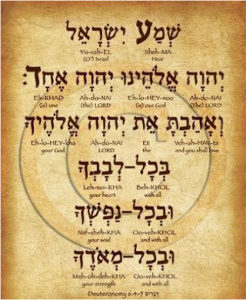What is the Bible? Well, it depends on who you ask, since the Catholics have a different Bible than most Protestants, and the Jewish Bible is much different than those two. We can say, however, that the principal texts of the Bible are the Old Testament and the New Testament. The Hebrew Bible that is central in Judaism is just The Old Testament, whereas the Christian Bible includes both The Old and New Testament. There is no scholarly consensus on when these texts were written, but we presume that the Old Testament was written between about 1200 and 165 BCE and the New Testament was written between 50 and 100 CE.

The Old Testament books were mostly written in Ancient Hebrew, as pictured, which is very distinct from the English we speak today. Translating text from Ancient Hebrew to English is even more challenging because Hebrew is written with no vowels or punctuation marks. 
Even scribes struggled with deciphering this text. As we can see in this image, scribes often added annotations in the margins and really engaged with the text as they tried to unpack what it all really meant.
In order to visualize the difficulty in translating such a text, we can look to one of the most popular Bible verses, John 3:16, written with small spaces and without vowels:

The verse in English is:
For God so loved the world, that he gave his only begotten Son, that whosoever believeth in him should not perish, but have everlasting life.
As we can see, it is incredibly difficult to decipher a text like that, so we must acknowledge that as we read the Bible.
Hebrew has about 8000 words, in comparison to the 100,000 or more of English, so each word has a broader possible meaning.
We can see two examples of ambiguous wording in the Shema, a central Jewish prayer taken from the Bible, beginning with Deuteronomy 6:4. It is the oldest fixed daily prayer in Judaism, recited morning and night. This prayer is so central to Judaism that even in Papua New Guinea, a nation with a very small Jewish population, we can see indigenous people reciting this prayer.
A tribe from the Jambitange village in Papua New Guinea reciting the Shema prayer

The word shema itself can be translated to either “hear” or “obey” in English. Is God telling Israel just to listen to his instructions or is he also commanding them to obey? There is an important distinction there that is missing in both the original Hebrew and translation. Furthermore, the word echad (first word in the second line) is translated to “one” in most English versions of the Bible, yet there is debate over what echad really means in this context. Some translate echad to “alone,” as in YHWH (the Jewish God) alone is our God. Others believe that echad represents the singular quality of God, suggesting that God does not consist of multiple entities.

The world of biblical times is much different than those times in which it has been translated, extending all the way to today. This culture gap is another factor that makes biblical translation difficult. Translators can’t help but try to read the Bible through their perspective because they don’t have the context of ancient times. For example, there are many verses about money in the Bible (Deuteronomy 23:19, Exodus 22:25), but money in the Old Testament means something entirely different than what money means in the Literal Standard Version that was released in 2020. Money in the time of the Hebrew Bible was in shekels. In order to weigh out the quantity of silver needed for a shekel, a rock was used, as seen in the above image. With a rock as the closest thing they have to currency, there is no way that the writers of the Bible would have envisioned a world with banks, checks, and credit cards. Although the text of the Bible may not have changed over time, the world has.
Saint Jerome was a priest, historian, and theologian who is best known for his translation of the Bible into Latin, the Vulgate translation, around 400 CE. Even he admitted the difficulty of translating the Bible, stating:
“When we translate the Hebrew into Latin, we are sometimes guided by conjecture.”
Jean Le Clerc, a Swiss Protestant theologian and scholar of the 17th century, echoed this sentiment by claiming:
“The learned merely guess at the sense of the Old Testament in an infinity of places.”
Thus, we see that translating the Bible is no easy feat and there is no way to prevent the distortion of the original message as the text is interpreted by multiple authors and converted between many languages.